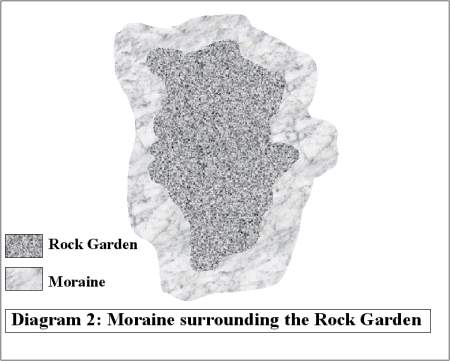This article was originally published on the web on thealpinegarden.com however that website is defunct at May 2015. The copyright is with the original owners of thealpinegarden.com
The Rock Garden - planning
by Alan Grainger
Planning - Construction
Introduction
The Rock Garden.....a somewhat innocuous phrase but surrounded with controversy.
Should a 'rock garden' be constructed of rocks with plants in mind, or of plants with rocks in mind? Should it be called a 'Rock Garden' or a 'Rockery'. Should it be filled with 'Rock Plants' or 'Alpine plants'. Should you use Sandstone or Waterworn Limestone? Should it be in the open or in the shade? and on and on and on.
The choice, is fortunately, entirely personal and judging from some of the rock gardens I have seen, the controversy will rage forever. Some of the more famous ones at Kew, Edinburgh, Denver and the like, are without doubt beautifully constructed and planted by caring enthusiasts but then who has the land or the finances to go to this extreme? For the purposes of this article, I wish to deal with the rock garden that is to be built and planted by the keen cultivator of alpine plants who considers that the true home for an alpine is in the garden and not in a pot. The person who has just enough room to make a feature in their garden and to create a suitable habitat for their much treasured and hard sought-after plants.
The Drawing Board
So where to start?
As with most successful ventures, preparation is the key. Before embarking on a mammoth and arduous construction phase, there are some points to consider, sooner rather than later.
Firstly, where will the rock garden be situated?
 Again this is a personal choice but some guidance can be offered here. Few, if any, rock garden plants will tolerate deep shade over a long period and so the rock garden should be given a good, open aspect. The practice of building a rock garden against the garage wall, or at the foot of the garden to hide the compost heap should be discouraged. A rock garden should be a major feature of your garden, be it on a small or a grand scale and should not be confined to some 'out of the way' area. So too, should the practice of building a huge mound in the centre of the lawn, be discouraged. In addition to looking somewhat unnatural, they take on the appearance of, what has been described by that greatest rock gardener of all time, Reginald Farrer, "a dog's grave".
Again this is a personal choice but some guidance can be offered here. Few, if any, rock garden plants will tolerate deep shade over a long period and so the rock garden should be given a good, open aspect. The practice of building a rock garden against the garage wall, or at the foot of the garden to hide the compost heap should be discouraged. A rock garden should be a major feature of your garden, be it on a small or a grand scale and should not be confined to some 'out of the way' area. So too, should the practice of building a huge mound in the centre of the lawn, be discouraged. In addition to looking somewhat unnatural, they take on the appearance of, what has been described by that greatest rock gardener of all time, Reginald Farrer, "a dog's grave".
Having decided on the situation, the choice of rock for the construction needs to be considered. It has often been said that one should choose 'local' stone for the work, however, finding local stone in the middle of a metropolis is not the easiest of tasks. There are two reasons for searching out the local stone....availability and transportation costs. If you have a quarry in your neighbourhood, it would be worth going along, if for no other reason than to determine just what stone your city is built upon. The earth scientist (aka geologist) will tell you that there are many different types of rock. This alpine gardener will tell you that for the purposes of this article, there are but two........ Sandstone and Limestone. Why but two? Because these are the traditional materials for a rock garden. Some rock gardeners use Tufa in the construction, a light, porous rock which can be drilled and actually have plants growing out of it. Here in the UK, I would be reluctant to use tufa on a large scale as it is most definitely prone to encouraging moss formations and eradication is difficult. Experiment by all means, but aesthetically and practically, one cannot go wrong when using either of the aforementioned types.
Another determining factor will be size. This should be in perspective with the rest of your garden plan but consider this:- if your rock garden is simply going to be a collection of rocks say 1.5m x 1m, then wouldn't it make more sense to construct a raised bed? I would not like to put a minimum size on what is acceptable but I should think that at least 8-10 sq metres should be a reasonable size for a modern garden and not too difficult to design and build.
Designing the Rock Garden
 This is a most enjoyable exercise...(on paper, that is. It can also be physically demanding).
This is a most enjoyable exercise...(on paper, that is. It can also be physically demanding).
If you have a garden with a gentle slope, then you are favoured indeed. The rock garden can be cut from the existing ground following the natural contours of the land. If however, your garden is flat, then it will be necessary for you to think about building a rock garden based on an outcrop principle where the rocks form layers or terraces to accommodate the plants. Whichever is the case, great care should be taken in the initial design stage.
Choose your rock carefully.............
The cost of this material is relatively expensive and you won't get much rock for your money. The cost of transporting the rock to your garden is also a factor that will need to be taken into consideration. If you are fortunate enough to have a local quarry, then go and hand pick the pieces of rock that fit your design ideas, remembering also that once the rock has been delivered, you will have to move it into position. Consider at this point, that on average, 1 piece of rock measuring 45cm x 23cm x 23cm (18" x 9" x 9") will weigh approximately 43kg (95lb). This equates to about 25 pieces, of that size, per tonne. Now depending upon what size you want your rock garden, you will have some idea of how many pieces of rock you are going to have to handle and what weight you will need to order. At this point and certainly before ordering any rock, it would be worthwhile to draw a scale model of how you anticipate your rock formations to look.
The next stage involves transferring your plan onto the site. Mark out the total area and shape that you have designed. This will give you an indication of the perspective of the finished article.
Remember at this point to allow an area for scree/moraine type plants that will be at the base of the rock garden (See Diagram 2.) Do not be afraid to modify your design at this stage....it could save a lot of heartache at a later time.
And so to construction...